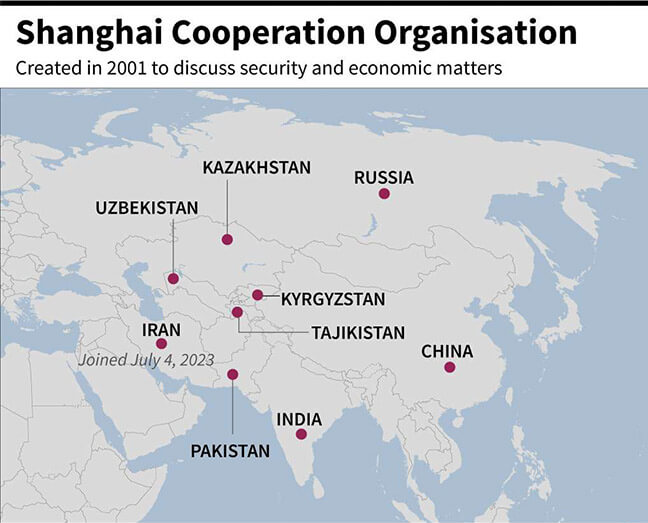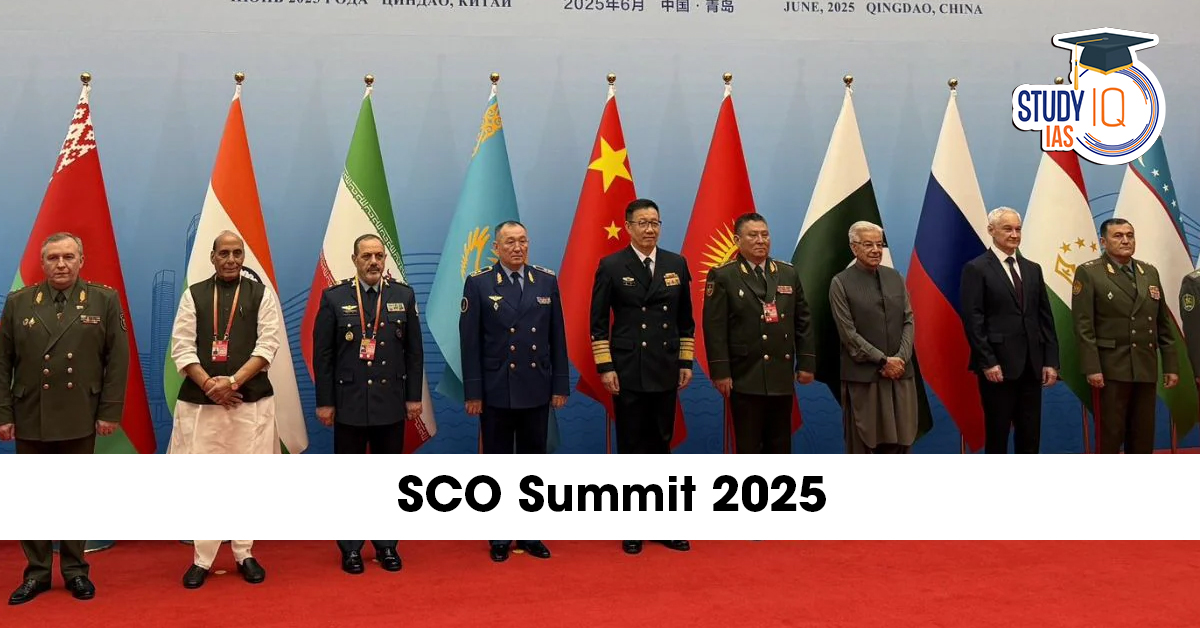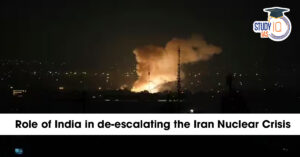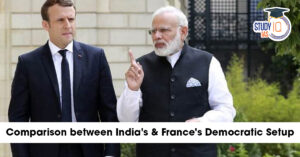Table of Contents
The recently concluded 25th SCO Summit in Tianjin adopted key reforms, condemned terrorism and expanded partnerships.
The Shanghai Cooperation Organisation (SCO) Summit 2025 was held in Tianjin, China, bringing together world leaders to discuss pressing issues such as terrorism, security, economic cooperation, and regional stability. The summit came at a crucial time when global geopolitics is shifting rapidly, with multipolarity and regional alliances gaining significance.
Key Takeaways from the Tianjin SCO Summit 2025
Major Initiatives and Announcements
Strong Condemnation of Terrorism: All 10 members unanimously condemned terrorism in all forms & called for ending the cross-border movement of terrorists.
- Specific references: Pahalgam attack & 2 other attacks in Pakistan.
| Significance |
|
- Global Governance Initiative (GGI) – Proposed by Chinese President Xi Jinping, a Vision for a more just and equitable global order, prioritising the Global South.
- Core pillars:
- Sovereign Equality: All countries, regardless of size or wealth, should have an equal voice.
- Rule of Law: Strict adherence to UN Charter; opposition to double standards.
- Multilateralism: Strengthen the UN’s role, oppose unilateralism.
- Fairness & Justice: Resist Cold War mentality, bullying, and promote multipolarity.
- Core pillars:
- Artificial Intelligence Cooperation Roadmap: Tianjin Declaration reaffirmed joint efforts in AI:
- Principles: Equal rights to develop and use AI, minimise risks, and enhance accountability.
- Initiatives: Proposal for an AI collaboration centre & Promotion of open-source AI models.
- Challenge: Regulating cross-border use of open-source AI.
- Proposal for an SCO Development Bank:
- Aim: Reduce reliance on the U.S. dollar and create a financial alternative. Inspired by AIIB (2014).
- China pledged:
- 2 billion yuan ($280 million) in free aid for SCO members.
- 10 billion yuan ($1.4 billion) in loans over the next three years.
- Institutional Developments within SCO:
- Observer & Dialogue Partner status merged into a single category: Partner status.
- Laos was admitted as a new partner country, raising the total to 27 states (10 members + 17 partners).
- Unity and Solidarity: President Xi called on members to “seek common ground while putting aside differences” and strengthen SCO cohesiveness amid global turbulence.
Key Engagements
- India-China Engagement: First Modi–Xi meeting on Chinese soil in 7 years. Both pledged to act as “partners, not rivals.”
- Xi-Putin-Modi Troika:
- Symbolic gesture: Three leaders holding hands, projecting unity of Asian powers.
- For Russia: SCO provides a stage where Putin is not isolated despite Western sanctions.
- For India: Opportunity to signal strategic options beyond the U.S.
- India-Russia talks: President Putin highlighted trust and friendship with India.
| India’s Strategic Messaging at Tianjin |
|
The Tianjin SCO Summit 2025 was less about immediate breakthroughs and more about symbolism and long-term narratives. China used it to push the Global Governance Initiative, Russia used it to showcase resilience against isolation, while India balanced carefully – highlighting terrorism, sovereignty, and ethical technology.
What is the SCO?
The Shanghai Cooperation Organisation (SCO), founded in 2001, is a political, economic, and security alliance that includes countries from Asia and Eurasia. Its founding members were China, Russia, Kazakhstan, Kyrgyzstan, Tajikistan, and Uzbekistan. Over time, the SCO expanded to include India and Pakistan in 2017, making it one of the largest regional organisations in terms of population and geographical coverage.

In 2023, Iran also became a full-fledged member, adding to the SCO’s strategic importance. Currently, countries such as Belarus, Turkey, and Mongolia participate as observers or dialogue partners, highlighting the growing influence of this grouping. The SCO’s core objectives are:
- Regional security cooperation, particularly counterterrorism, separatism, and extremism.
- Economic development and connectivity, focusing on infrastructure, trade, and energy cooperation.
- Cultural and people-to-people exchanges, aimed at strengthening ties among member states.
Permanent Bodies of the SCO
- SCO Secretariat (Beijing): Coordinates activities, meetings, and communication among members.
- Regional Anti-Terrorist Structure (RATS) (Tashkent, Uzbekistan): Dedicated to security and counter-terrorism cooperation.
| SCO-RATS: Its Role and Functioning |
|
Global Significance of SCO Summit 2025
The Tianjin SCO Summit 2025 comes at a critical juncture in global politics. The SCO has increasingly been seen as a counterweight to Western-led alliances like NATO and the G7. With China and Russia playing leading roles, the SCO represents a shift towards a multipolar world order, where regional blocs assert greater influence.
The summit is significant because:
- It provides a platform for dialogue among rival countries such as India and Pakistan, helping ease tensions.
- It strengthens China-Russia strategic coordination, particularly amid Western sanctions on Moscow.
- It offers smaller Central Asian states a platform to balance ties between major powers.
The Role of India in SCO 2025
India, as a key SCO member, will play a crucial role in the 2025 summit. New Delhi’s focus will be on:
- Enhancing regional connectivity projects without compromising sovereignty.
- Highlighting concerns about terrorism and urging stronger counterterrorism measures.
- Balancing ties with Russia and Central Asia while maintaining strategic caution towards China and Pakistan.
India’s participation will also signal its growing role in Eurasian geopolitics, as it balances its engagements with both the West and the East.
Significance of SCO for India
- Counter-Terrorism Platform: RATS database and intelligence sharing are crucial for tackling Pakistan-sponsored terror groups. Joint exercises enhance India’s preparedness.
- Access to Central Asia: India’s Connect Central Asia Policy finds a multilateral platform in the SCO. Helps overcome geographical constraints (since India lacks direct land access, with Pakistan blocking routes).
- Energy Security: Central Asia (Kazakhstan, Turkmenistan, Uzbekistan) holds abundant oil, gas, and uranium. SCO gives India opportunities to pursue projects like the TAPI pipeline.
- Balancing China and Pakistan: SCO provides India a forum to directly raise concerns with both countries.
- Strategic Autonomy and Multipolarity: India engages with Russia and China at SCO while also deepening ties with the U.S., QUAD, and IPEF. It strengthens India’s identity as a balancer in global geopolitics.
- Voice of the Global South: India uses SCO to highlight issues like climate change, digital inclusion, food security, and equitable globalisation. It enhances credibility among developing nations.
Why Tianjin Summit Matters for the World
The SCO Summit in Tianjin is not just about regional cooperation—it has global implications. By bringing together some of the world’s most influential leaders, including those from China, Russia, India, Pakistan, and Iran, the summit symbolises the rise of Eurasia as a central hub of global geopolitics.
As global power shifts from the West towards Asia, the 2025 Tianjin SCO Summit will highlight how regional organisations like the SCO are shaping international relations. It also shows how China is positioning itself not only as an economic powerhouse but also as a diplomatic leader capable of steering complex multilateral dialogues.
Challenges in the Functioning of SCO
- Divergent Strategic Interests of Members:
- India-China border tensions (Doklam 2017, Galwan 2020) undermine trust.
- India–Pakistan disputes often paralyse consensus on terrorism and connectivity.
- Russia aims to retain primacy in Eurasia, while China pushes economic dominance via BRI.
- Counter-Terrorism Contradictions: The SCO-RATS is effective in intelligence sharing, but definitions differ. “Three Evils” of terrorism, separatism, and extremism are not uniformly interpreted.
- Eg: India condemns Pakistan-backed terror outfits but China shields Pakistan diplomatically, blocking India’s efforts at the UN (e.g., listing of Masood Azhar).
- China’s Economic Dominance: Risk of SCO becoming a China-centric platform, eroding equality among members.
- Eg: China’s initiatives (BRI, SCO Bank proposal) overshadow smaller members.
- Overexpansion and Dilution: Consensus decision-making becomes harder with more diverse interests.
- Eg: With Iran’s entry and Turkey seeking membership, SCO risks becoming a crowded, incoherent forum.
- Geopolitical Polarisation: Perception of SCO as an anti-Western bloc, especially by U.S. and EU. India’s balancing act between QUAD/U.S. partnerships and SCO commitments becomes tricky.
- Institutional Weaknesses: SCO lacks strong enforcement or binding mechanisms.
- Eg: No permanent dispute resolution forum – limits effectiveness beyond declarations.
Way Forward
- Strengthen RATS and Counter-Terrorism Consensus: Develop common definitions of terrorism to avoid selective application. Expand the RATS mandate to include cyber-terrorism, narco-terrorism, and radical financing.
- Balance Economic and Security Agenda: Avoid the SCO being dominated by China’s BRI vision. Encourage projects in the digital economy, climate action, and health security for wider acceptance.
- Institutional Reforms: Move towards binding resolutions in areas like terrorism and connectivity. Strengthen the Secretariat for better coordination.
- Build Trust Through Dialogue: Use SCO as a confidence-building platform between rivals (India-China, India-Pakistan). Encourage backchannel diplomacy on border and terrorism issues.
- Controlled Expansion: Ensure future enlargement (Turkey, Afghanistan, etc.) does not dilute SCO’s focus. Adopt criteria for membership to keep cohesion.
- Engage Beyond Anti-West Narrative: SCO should avoid being seen purely as a counterweight to NATO or U.S. alliances. Promote inclusive multilateralism and collaboration with the UN, WTO, and WHO.


 Iran Nuclear Crisis and India’s Role f...
Iran Nuclear Crisis and India’s Role f...
 H1B Visa Program, Beneficiaries, Eligibi...
H1B Visa Program, Beneficiaries, Eligibi...
 Comparison Between India & France's ...
Comparison Between India & France's ...

























